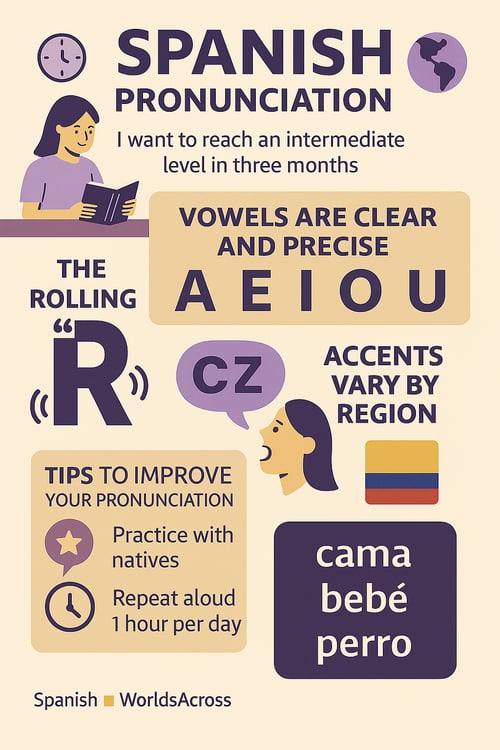A Beginner’s Guide to Spanish Pronunciation
Not long ago, I was chatting with some friends who are advanced Spanish learners. I asked them what advice they would give to beginners based on their extensive experience learning the language. Interestingly, four out of the five agreed on one key point. They explained that, aside from immersion and crucial interaction with native speakers, dedicating enough time to pronunciation practice is one of the best pieces of advice any Spanish beginner could receive. Motivated by this insight, we’ve prepared a Spanish pronunciation guide for beginners that will help you start your journey in this beautiful language in the best possible way. Let’s get started!
Mastering the Vowels
Mastering vowels is essential if you want to learn how to pronounce Spanish words correctly. Spanish has five vowels, and the good news is—they always sound the same. These five vowels have clear and consistent sounds. Unlike in English, they don’t change depending on the word.
- A as in cama (bed). It’s direct and always short.
- E as in bebé (baby). It’s consistent and clear.
- I as in sí (yes). It’s precise and sharp.
- O as in oso (bear). A rounded, defined sound.
- U as in uva (grape). It’s sharp and short.
Extra tip: Practice saying words that contain each vowel. For example: cama, café, maní, pozo, luz. Remember, they should sound clear and crisp!
The Famous R: The Big Challenge
When it comes to Spanish pronunciation for beginners, the R is one of the most important letters. There are two types of R, and knowing the difference between them is crucial for correct pronunciation. Here’s the breakdown:
- Soft R: This R is gentle and doesn’t require much effort. You’ll find it in words like cara (face), mora (berry), and loro (parrot).
- Strong R: This R is one of the most distinctive sounds in Spanish and also one of the hardest to master. You’ll find it in words like borrar (to erase), perro (dog), and carro (car).
How to practice it: Place your tongue behind your upper teeth, touching the palate, and blow quickly. If it sounds strange at first, don’t worry—it’s completely normal. With time and practice, you’ll get it!
Z, C, and S
Depending on where you are, these three consonants can sound different. For example, in Spain, Z and soft C are pronounced like the English “th” in “thing.” So, zorro sounds like “thorro” and cruce like “cruthe.”
However, in Latin America, these letters are pronounced just like an S. So zorro would be “sorro” and cruce becomes “cruse.”
LL and Y: A Mark of Rioplatense Spanish
If you want to know how to pronounce Spanish words correctly, you should understand how the sounds of LL and Y differ in Argentina and Uruguay compared to the rest of Latin America.
In most Latin American countries, both letters sound like a soft English Y, as in “yes.” However, in Argentina and Uruguay, they are pronounced like "sh" in “shoes.”
So instead of saying lluvia and calle, you’d hear shuvia and cashe. Interesting, right?
The Ñ: A Unique Sound
Of course, this Spanish pronunciation guide for beginners wouldn’t be complete without the beloved Ñ. To master this peculiar sound, think about the “ny” sound in the English word canyon. Focusing on that “ny” sound will help you reproduce the characteristic sound of the famous Spanish Ñ.

Tips to Improve Your Pronunciation
- Practice conscious pronunciation: Don’t just repeat words—aim to replicate each sound accurately. This will help you notice the differences between your pronunciation and the correct one, allowing you to make adjustments.
- Repeat out loud: When you encounter a tricky word, say it slowly and out loud. This lets you break it into syllables and master it piece by piece.
- Record your voice: When we practice alone, we often don’t realize how we sound. Record yourself practicing Spanish pronunciation and compare it with native speakers. Trying to imitate them as closely as possible is key.
- Get native feedback: Who better to correct you than native Spanish speakers? Try to engage with them—not only will you get familiar with their pronunciation, but they can also give you real-time corrections.
- Speak without fear: Lastly, now that you know how to pronounce Spanish words correctly, don’t be afraid of making mistakes. Every mistake is a chance to get better.
Mastering Spanish pronunciation can be a real challenge—but it’s worth the effort. It not only improves how others understand you, but it also makes your speech sound clear and melodic. We hope this Spanish pronunciation guide for beginners helps you kick-start your language-learning journey on the right foot.
Remember to practice a lot, surround yourself with Spanish speakers, and—most importantly—enjoy the process. See you next time!




